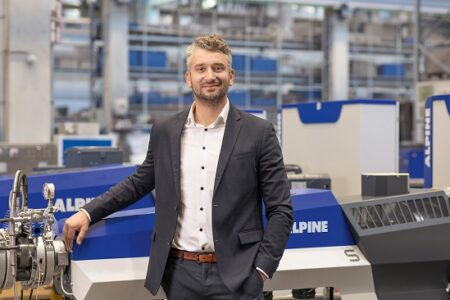Single-Material Composites: A New Era of Innovation Begins
Interview on the road to K 2025 with Konstantin Klein, Sales Director of Blown Film at Hosokawa Alpine AG
Mr. Klein, where does the sustainability concept in blown film extrusion start at Hosokawa Alpine?
We have been working extensively on recyclable packaging in blown film extrusion for a long time. We presented the first recyclable PE packaging and the first mono-material composite at K 2013. At that time, the topic was hardly discussed at all. The mono-material composites are produced with our MDO technology, which is based on the monoaxial stretching of blown film. We already made our first attempts in the early 2000s, rendering us pioneers in that field. Recyclable, sustainable packaging is not a new topic for Alpine Hosokawa.
Meanwhile, mono-material composites are on the rise.
That’s right. At K 2016, we saw the first signs of growing interest. Then a breakthrough came in 2019, with demand increasing enormously, along with a major increase in project requests. For us as a blown film line manufacturer, the topic of sustainable packaging is based on three pillars: one of them is the production of recyclable packaging from mono-materials. The second one is downgauging, i.e. the production of ever thinner film with consistent properties. And the third important pillar is packaging made from recyclates, whether post-industrial or post-consumer recyclates. In the past six or seven years, the momentum in these fields has increased significantly.
What challenges does mono-material packaging face?
Plastic packaging has become increasingly complex over the years. Today, packaging combines ergonomics, feel, design, freedom of form and, above all, product safety. Translating this complexity into a single type of packaging is a lengthy technological process. We have already come a long way in this regard – I would even go so far as to say that at present, a single-material packaging can cover the full range of packaging performance. We now have a number of options for creating barrier properties. The difficulties in the production process have also been eliminated. The major challenges in terms of maximum output, minimum waste and good further processability have therefore been overcome.
What tasks remain to be done?
Customers are increasingly demanding higher quality end products and greater machine efficiency. In terms of efficiency, the aim is to reduce material losses when changing production, and to reduce edge trimming. This is the key issue in the production of MDO films. It is also about minimising downtime and service intervals. In addition, customers are demanding a higher quality mono-material composite. At the end of the day however, the packaging should be cost-effective, so it’s all about increasing productivity. On the one hand, we achieve this through our technologies, such as the Trio System for minimising edge trimming, or the vacuum roller, which, in addition to reducing edge trimming, also ensures a high level of process reliability. On the other hand, we achieve it through our flexible machines, which enable an immediate response to market changes, and thereby a swift increase in capacity utilisation. Automation plays an important role in that regard. As is the case virtually everywhere else, our customers are struggling with a shortage of skilled workers, which is why they want us to install increasing numbers of assistance systems in our machines. The main goal is the so-called man-less machine, which requires very little skilled personnel to operate.
How flexible must machines be today?
The large machines – especially those used to manufacture mono-packaging – have to be extremely flexible. This is because they can currently only be fully utilised with mono- packaging in individual cases. Accordingly, such a machine must be able to produce an extremely wide range of products. A typical requirement from our markets is a seven-layer system with an MDO unit that can be used to produce stretched films for food packaging, i.e. stretched films with or without a barrier. At the same time however, this machine can also be used to produce standard products made of polyethylene or standard barrier films. This gives our customers the opportunity to serve existing markets while also driving innovation in their packaging. Added to this is the uncertainty regarding the future course of regulation. The flexible machine is an excellent solution in this respect, as it provides customers with the security of knowing they will be able to produce efficiently and profitably in ten years’ time as well.
What role do recyclates play in flexible packaging?
We are witnessing a continuous increase in demand for flexible packaging, particularly from the established European market. Spain and Germany are currently developing very well in this area. Packaging manufacturers are placing ever more importance on increasing the share of recycled materials, be it in simple packaging products such as bin liners, where the share of recycled materials can be up to 100 per cent, or in more sophisticated packaging with a material combination of new and recycled materials, where the proportion of recycled materials is constantly increasing. The challenges in processing recyclates lie in the inhomogeneous quality of the recycled materials. It is therefore challenging to produce a consistently high film quality.
#vdma #SustainablePackaging #CircularEconomy #PlasticsRecycling #BlownFilmExtrusion
#MonoMaterialComposites #FlexiblePackaging #RecyclablePlastics #PlasticSustainability
#AdvancedManufacturing #HosokawaAlpine #K2025 #EcoFriendlyPackaging
#PlasticInnovation #MDOTechnology #FutureOfPlastics #modernplasticsindia
#modernplasticsasia #plasticsislife #plasticstalk #modernplastics #modernplasticsworld
#pasticsnews #plasticsisgood #plasticsplane #plasticmagazine #plasticIndustry
#innovations #modernplasticsmiddleeast #indianmagazine #modernplasticsamerica
#modernplasticsbangladesh #modernplasticsasia #modernplasticsitaly

